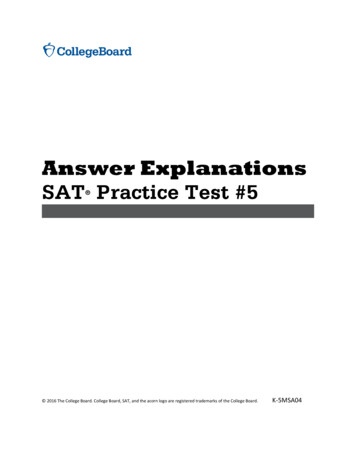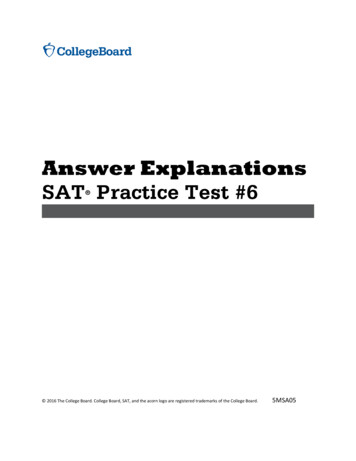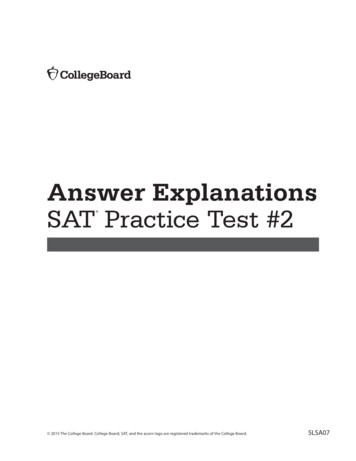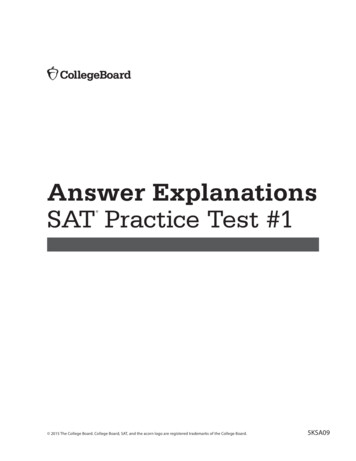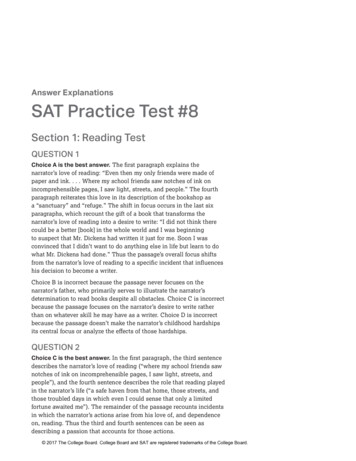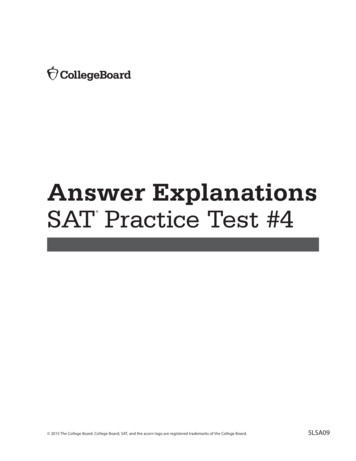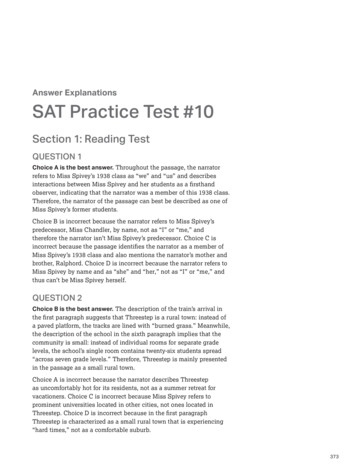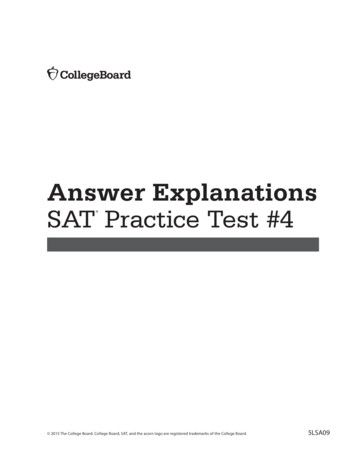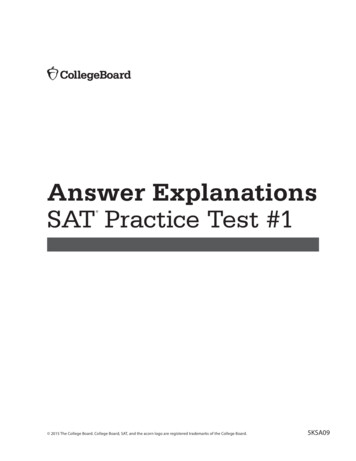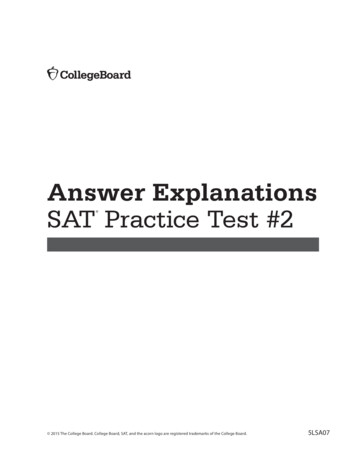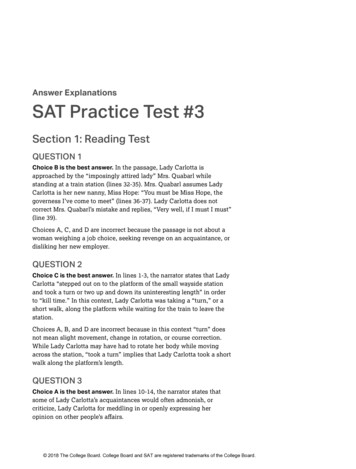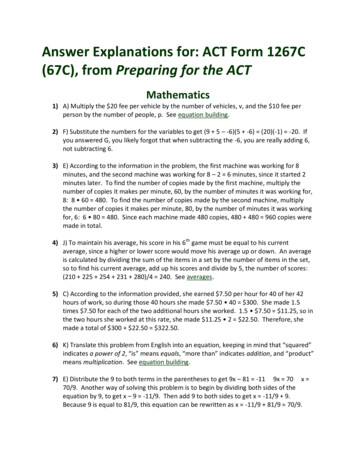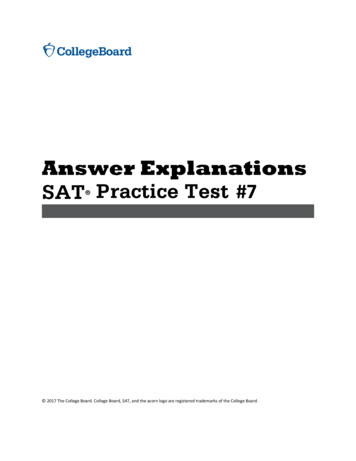
Transcription
Answer Explanations#7 2017 The College Board. College Board, SAT, and the acorn logo are registered trademarks of the College Board.
Answer ExplanationsSAT Practice Test #7Section 1: Reading TestQUESTION 1.Choice D is the best answer. The final sentence of the first paragraphmakes clear that before adopting his daughter, the weaver Silas wasgreedy for gold and chained to his work, “deafened and blinded moreand more to all things except the monotony of his loom.” But afteradopting Eppie, Silas became more interested in life outside his job:“Eppie called him away from his weaving, and made him think allits pauses a holiday, reawakening his senses with her fresh life.” Amajor theme of the passage can be seen in this transformation, as itrepresents how loving a child can improve or change a parent’s life.Choice A is incorrect because even if the passage implies thatSilas was too materialistic before his daughter’s arrival in his life,his greediness was a personal characteristic only, not a societalone; whether the society Silas lives in is overly materialistic isnever addressed. Choice B is incorrect because even if the passagerepresents the “moral purity” of children, it does so only indirectlyand not as a major theme. Choice C is incorrect because the passageaddresses childhood enthusiasm and curiosity more than “naïveté” andnever discusses the length or “brevity” of that naïveté.QUESTION 2.Choice A is the best answer. The first sentence of the first paragraphnotes that “Unlike the gold . . . Eppie was a creature of endless claimsand ever-growing desires, seeking and loving sunshine, and livingsounds, and living movements; making trial of everything, with trustin new joy, and stirring the human kindness in all eyes that looked onher.” These lines make clear that in contrast to Silas’s gold, his newdaughter is vibrant and alive.Choices B, C, and D are incorrect because the lines from the firstparagraph cited above reveal Eppie’s interest in “living sounds” and“living movements” and thus characterize her vitality in comparison tothe gold, rather than her durability, protection, or self-sufficiency.1081
QUESTION 3.Choice A is the best answer. In the first paragraph, the narratordescribes Silas as having been so obsessed as to have felt required toworship the gold “in close-locked solitude,” with “his thoughts in anever-repeated circle” centered on his hoard. Moreover, this obsessioncompelled him to “sit weaving longer and longer, deafened and blindedmore and more to all things except the monotony of his loom and therepetition of his web.” These lines convey the extent to which Silas’sbehaviors were determined by his obsession.Choice B is incorrect because the narrator does not make it seem asif Silas’s gold could reproduce on its own, with the first paragraphsuggesting that his hoard was a consequence of hard work, hisbeing “deafened and blinded more and more to all things exceptthe monotony of his loom and the repetition of his web.” Choice Cis incorrect because even if the first paragraph mentions that, afterEppie’s arrival, Silas thinks about “the ties and charities that boundtogether the families of his neighbors,” the passage never addresseshow Silas interacted with those neighbors previously. Choice D isincorrect because the third paragraph makes clear that Silas is not onlyable to recall life before Eppie, but that with her in his life, “his mindwas growing into memory.”QUESTION 4.Choice B is the best answer. The first paragraph of the passagedescribes Eppie as “a creature of endless claims and ever-growingdesires,” one who is “making trial of everything.” In this context, her“making trial of everything” can be read as her acting on her curiosityby striving to experience the world around her.Choices A, C, and D are incorrect because in the context of her“making trial of everything,” Eppie can be seen as curious, not friendly(choice A), disobedient (choice C), or judgmental (choice D).QUESTION 5.Choice D is the best answer. In the first paragraph, the narratorindicates that with the arrival of Eppie, Silas’s thoughts turn fromhis work and his gold toward Eppie’s future and his life with her:“Eppie was an object compacted of changes and hopes that forcedhis thoughts onward, and carried them far away from their old eagerpacing towards the same blank limit — carried them away to the newthings that would come with the coming years.” By influencing Silasto think “onward” and of “the coming years,” Eppie prompts Silas toenvision a far different future than he would experience otherwise.Choice A is incorrect because although the passage implies that Silasis less obsessed with money than before, there is no indication that hehas actually renounced his desire for it. Choice B is incorrect becausealthough the passage explains that Silas spends time outdoors afterthe arrival of Eppie, there is no indication that her presence has1082
Answer Explanations SAT Practice Test #7necessarily changed his understanding of his place in nature. ChoiceC is incorrect because at no point in the passage is Silas shownaccepting help from anyone.QUESTION 6.Choice B is the best answer. The previous question asks whatconsequence Silas has experienced as a result of adopting Eppie. Theanswer, that he begins to imagine a new future for himself and her, issupported in the first paragraph: “but Eppie was an object compactedof changes and hopes that forced his thoughts onward, and carriedthem far away from their old eager pacing towards the same blanklimit — carried them away to the new things that would come with thecoming years.”Choices A, C, and D are incorrect because the lines cited do not supportthe answer to the previous question about the consequence of Silas’sadoption of Eppie, instead describing Silas’s life before Eppie entered it(choice A), how he occasionally acts in her presence (choice C), and thechanges in Eppie’s perception of the world as she ages (choice D).QUESTION 7.Choice C is the best answer. In the second paragraph, the descriptionof Silas and Eppie’s interaction outdoors conveys the extent to whichhe has changed since her arrival: where he once worked all day athis loom to earn more and more money, he now “might be seen in thesunny mid-day” strolling with her, accepting the flowers she bringshim, or listening to birdcalls with her. With these experiences alsocome “crowding remembrances” of his early life — the life he led beforeamassing his hoard of gold. In its entirety, the paragraph can thereforebe seen as illustrating the profound change into a more sociable beingthat Silas has undergone as a result of parenting Eppie.Choice A is incorrect because the second paragraph does not presenta particular moment when Silas realizes that Eppie has changed himbut instead describes a pattern of behavior indicative of that change.Choice B is incorrect because the second paragraph shows the benefitsSilas derives from Eppie’s presence, rather than any sacrifices he hasmade for her. Choice D is incorrect because the second paragraphdramatizes a change in Silas’s life overall, rather than showing achange in the dynamic that has arisen between Silas and Eppie.QUESTION 8.Choice B is the best answer. The third paragraph of the passage showsthat as Eppie learns more and more, Silas reengages with life: “Asthe child’s mind was growing into knowledge, his mind was growinginto memory: as her life unfolded, his soul, long stupefied in a coldnarrow prison, was unfolding too, and trembling gradually into fullconsciousness.” As Eppie grows into a world that is new to her, Silasrecovers a world he’d largely forgotten.1083
Choice A is incorrect because the narrator portrays Eppie as beingcurious and eager, not physically vulnerable, and also implies thatSilas is becoming ever more emotionally robust, not psychologicallyfragile. Choice C is incorrect because the only connection the narratormakes regarding Silas’s former greed and Eppie’s presence in his lifeis that she has brought an end to his obsessive pursuit of wealth.Choice D is incorrect because the narrator does not address Silas’smortality in any way but rather shows him becoming more and morealive through Eppie’s love.QUESTION 9.Choice D is the best answer. The previous question asks whatconnection the narrator draws between Eppie and Silas. The answer,that as she learns more about the world, he becomes more involvedin it, is supported in the third paragraph: “As the child’s mind wasgrowing into knowledge, his mind was growing into memory: as herlife unfolded, his soul, long stupefied in a cold narrow prison, wasunfolding too, and trembling gradually into full consciousness.”Choices A, B, and C are incorrect because the lines cited do notsupport the answer to the previous question about the connectionbetween Eppie and Silas, instead contrasting Silas’s fixation on hisgold with Eppie’s curiosity (choice A) and describing Silas’s habitualbehavior when accompanying Eppie outdoors (choices B and C).QUESTION 10.Choice D is the best answer. In the last paragraph, the narrator states,“Also, by the time Eppie was three years old, she developed a finecapacity for mischief, and for devising ingenious ways of beingtroublesome.” In this context, the word “fine” most nearly means keen,or acute.Choices A, B, and C are incorrect because in the context of adescription in which Eppie was said to have a “fine capacity formischief,” the word “fine” most nearly means keen, or acute, notacceptable (choice A), delicate (choice B), or ornate (choice C).QUESTION 11.Choice D is the best answer. The first paragraph of the passageexplains the theory of two MIT business scholars who believe thattechnological advances in the workplace could lead to fewer jobsfor human workers, explaining that they “foresee dismal prospectsfor many types of jobs as these powerful new technologies areincreasingly adopted not only in manufacturing, clerical, and retailwork but in professions such as law, financial services, education,and medicine.” The fifth paragraph of the passage, however, offersa contrasting view, citing a Harvard economist who “says that nohistorical pattern shows these shifts leading to a net decrease in1084
Answer Explanations SAT Practice Test #7jobs over an extended period.” Combined, these different opinionsindicate the main purpose of the passage, which is to assess how newtechnologies in the workplace might affect job growth as a whole.Choice A is incorrect because the passage does not examine howworkers’ lives have been affected by technology during the last century.Choices B and C are incorrect because the passage does not advocateor argue for a course of action; instead, the passage considers bothsides of an issue, taking no position of its own.QUESTION 12.Choice A is the best answer. In the first paragraph of the passage,Brynjolfsson and McAfee clearly state that technological advancessince the year 2000 have led to low job growth in the United States:“MIT business scholars Erik Brynjolfsson and Andrew McAfee haveargued that impressive advances in computer technology — fromimproved industrial robotics to automated translation services —are largely behind the sluggish employment growth of the last 10 to15 years.”Choice B is incorrect because although Brynjolfsson and McAfeeassert that certain “changes” have occurred in the workplace asa result of technological advancement, they offer only tentativespeculation that those changes may be reflected globally. Choice Cis incorrect because the passage notes a decrease, rather than anincrease, in skilled laborers. Choice D is incorrect because the passagemakes no mention of the global creation of new jobs, even speculatingthat jobs may have been negatively impacted in technologicallyadvanced nations.QUESTION 13.Choice A is the best answer. The previous question asks whatBrynjolfsson and McAfee say has resulted in the workplace fromadvances in technology since the year 2000. The answer, that lowjob growth has resulted from these advances, is supported in thefirst sentence of the first paragraph: “MIT business scholars ErikBrynjolfsson and Andrew McAfee have argued that impressiveadvances in computer technology — from improved industrial roboticsto automated translation services — are largely behind the sluggishemployment growth of the last 10 to 15 years.”Choices B, C, and D are incorrect because the lines cited do notsupport the answer to the previous question about what Brynjolfssonand McAfee say has resulted in the workplace from advances intechnology since the year 2000; instead they point to industries notunder specific consideration by Brynjolfsson and McAfee (choice B),speculate as to whether changes might also be happening in othercountries (choice C), and explain the importance of productivity in themarketplace in the decades following World War II. (choice D).1085
QUESTION 14.Choice D is the best answer. The second sentence of the thirdparagraph reads, “In economics, productivity — the amount of economicvalue created for a given unit of input, such as an hour of labor — isa crucial indicator of growth and wealth creation.” In this context, theprimary purpose of the appositive (“the amount of economic value . . .such as an hour of labor”) is to define “productivity.”Choices A, B, and C are incorrect because in the context of the thirdparagraph, the appositive (“the amount of economic value . . . suchas an hour of labor”) is clearly provided to help explain the term“productivity,” not to describe a process (choice A), highlight adilemma (choice B), or clarify a claim (choice C).QUESTION 15.Choice D is the best answer. The third paragraph states that “thepattern is clear: as businesses generated more value from theirworkers, the country as a whole became richer.” In this context, theword “clear” most nearly means obvious, or unmistakable.Choices A, B, and C are incorrect because in the context of thethird paragraph, the word “clear” can be se
Answer Explanations SAT Practice Test #7 Section 1: Reading Test QUESTION 1. Choice D is the best answer. The final sentence of the first paragraph makes clear that before adopting his daughter, the weaver Silas was greedy for gold and chained to his work, “deafened and blinded more and more to all things except the monotony of his loom.” But after adopting Eppie, Silas became more .
